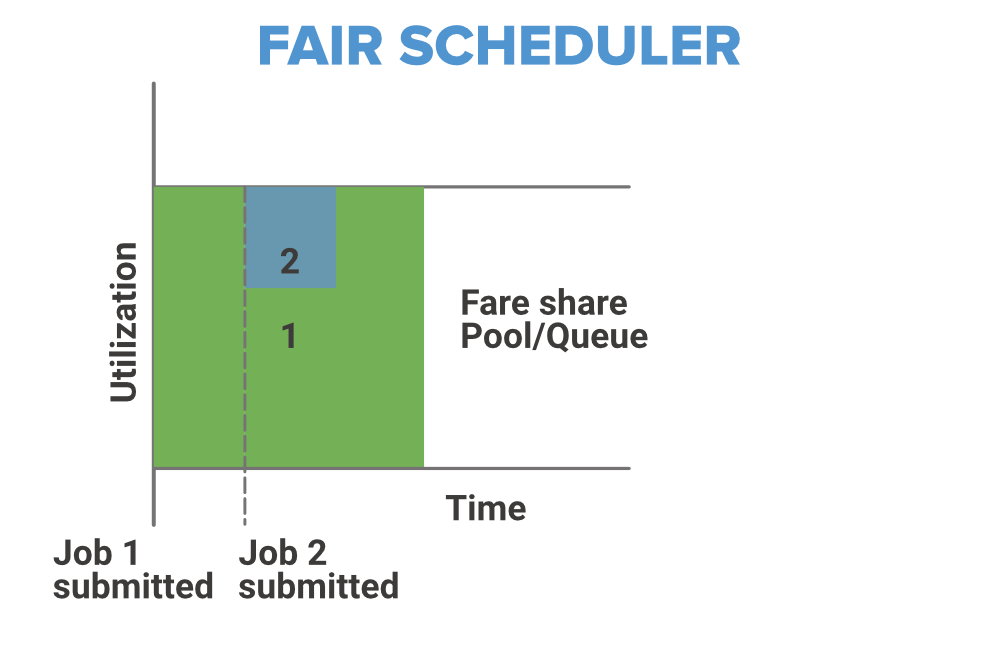Hadoop – Schedulers and Types of Schedulers
Last Updated :
15 Feb, 2022
In Hadoop, we can receive multiple jobs from different clients to perform. The Map-Reduce framework is used to perform multiple tasks in parallel in a typical Hadoop cluster to process large size datasets at a fast rate. This Map-Reduce Framework is responsible for scheduling and monitoring the tasks given by different clients in a Hadoop cluster. But this method of scheduling jobs is used prior to Hadoop 2.
Now in Hadoop 2, we have YARN (Yet Another Resource Negotiator). In YARN we have separate Daemons for performing Job scheduling, Monitoring, and Resource Management as Application Master, Node Manager, and Resource Manager respectively.
Here, Resource Manager is the Master Daemon responsible for tracking or providing the resources required by any application within the cluster, and Node Manager is the slave Daemon which monitors and keeps track of the resources used by an application and sends the feedback to Resource Manager.
Schedulers and Applications Manager are the 2 major components of resource Manager. The Scheduler in YARN is totally dedicated to scheduling the jobs, it can not track the status of the application. On the basis of required resources, the scheduler performs or we can say schedule the Jobs.

There are mainly 3 types of Schedulers in Hadoop:
- FIFO (First In First Out) Scheduler.
- Capacity Scheduler.
- Fair Scheduler.
These Schedulers are actually a kind of algorithm that we use to schedule tasks in a Hadoop cluster when we receive requests from different-different clients.
A Job queue is nothing but the collection of various tasks that we have received from our various clients. The tasks are available in the queue and we need to schedule this task on the basis of our requirements.

1. FIFO Scheduler
As the name suggests FIFO i.e. First In First Out, so the tasks or application that comes first will be served first. This is the default Scheduler we use in Hadoop. The tasks are placed in a queue and the tasks are performed in their submission order. In this method, once the job is scheduled, no intervention is allowed. So sometimes the high-priority process has to wait for a long time since the priority of the task does not matter in this method.
Advantage:
- No need for configuration
- First Come First Serve
- simple to execute
Disadvantage:
- Priority of task doesn’t matter, so high priority jobs need to wait
- Not suitable for shared cluster

2. Capacity Scheduler
In Capacity Scheduler we have multiple job queues for scheduling our tasks. The Capacity Scheduler allows multiple occupants to share a large size Hadoop cluster. In Capacity Scheduler corresponding for each job queue, we provide some slots or cluster resources for performing job operation. Each job queue has it’s own slots to perform its task. In case we have tasks to perform in only one queue then the tasks of that queue can access the slots of other queues also as they are free to use, and when the new task enters to some other queue then jobs in running in its own slots of the cluster are replaced with its own job.
Capacity Scheduler also provides a level of abstraction to know which occupant is utilizing the more cluster resource or slots, so that the single user or application doesn’t take disappropriate or unnecessary slots in the cluster. The capacity Scheduler mainly contains 3 types of the queue that are root, parent, and leaf which are used to represent cluster, organization, or any subgroup, application submission respectively.
Advantage:
- Best for working with Multiple clients or priority jobs in a Hadoop cluster
- Maximizes throughput in the Hadoop cluster
Disadvantage:
- More complex
- Not easy to configure for everyone

3. Fair Scheduler
The Fair Scheduler is very much similar to that of the capacity scheduler. The priority of the job is kept in consideration. With the help of Fair Scheduler, the YARN applications can share the resources in the large Hadoop Cluster and these resources are maintained dynamically so no need for prior capacity. The resources are distributed in such a manner that all applications within a cluster get an equal amount of time. Fair Scheduler takes Scheduling decisions on the basis of memory, we can configure it to work with CPU also.
As we told you it is similar to Capacity Scheduler but the major thing to notice is that in Fair Scheduler whenever any high priority job arises in the same queue, the task is processed in parallel by replacing some portion from the already dedicated slots.
Advantages:
- Resources assigned to each application depend upon its priority.
- it can limit the concurrent running task in a particular pool or queue.
Disadvantages: The configuration is required.

Please Login to comment...